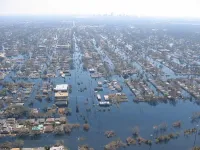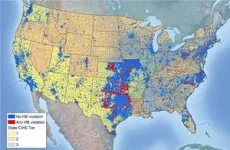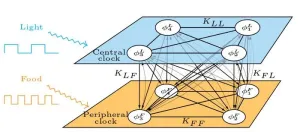(Press-News.org) American Geophysical Union
5 September 2023
Release 23-33
For Immediate Release
This press release is available online at: https://news.agu.org/press-release/disparities-in-who-dwells-behind-us-levees/
Key points:
Tens of millions of people live in areas protected by at least one levee in the United States
Nationally, members of historically disadvantaged or underserved groups are more likely to be overrepresented in communities living behind levees
People of Hispanic descent are most likely to be overrepresented behind levees, with ~40% overrepresentation nationally
The Northeast and West had the greatest disparities in who lives behind levees
Contact information for the researcher:
Farshid Vahedifard, Tufts University, farshid.vahedifard@tufts.edu (UTC-4 hours)
WASHINGTON — In the United States, tens of millions of people live behind levees, but historically disadvantaged groups are more likely to live behind subpar levees and have fewer resources to maintain critical levee infrastructure, a new study reveals. The study is the first to quantify the national disparity of disadvantaged communities living in levee-protected areas, which puts people at increased risk of flooding and other issues.
The United States is crosscut by several thousand miles of levees. Most are earthworks dating to the 18th and 19th centuries, when they were built to protect farmers’ fields and small riverside communities. They were not designed or built to serve as critical infrastructure protecting millions of people 150 years later.
“The overall impact of a levee failure depends heavily on the community living behind the levee,” said Farshid Vahedifard, a civil engineer at Tufts University who led the study. “Levees are one of the most important examples of infrastructure inequity, which is a longstanding issue in our country. The recent infrastructure law shows there’s consensus that we have to do something, but we need to have a better understanding of the problem before we can tackle it. This paper is a step toward that.”
The study was published in Earth’s Future, which publishes interdisciplinary research on the past, present and future of our planet and its inhabitants.
When properly maintained, levees essentially serve as built-up, armored riverbanks, protecting the area behind them from flooding. But when a levee is left to crumble, either because of a lack of resources or knowledge, it increases the community’s risk of catastrophic levee failure and subsequent flooding. Most levees in the country today are in a state of disrepair and are approaching or at the end of their useful life, according to a 2021 assessment of levee infrastructure.
The 2022 Jobs Act set aside $1.2 billion for infrastructure with an emphasis on historically underserved or disadvantaged communities. A previous estimate suggested the U.S. needs to allocate approximately $27 billion over the next 10 years to bring the country’s infrastructure up to acceptable standards before climate change is factored in.
“No matter how much funding we get, there’s greater need,” Vahedifard said. “That’s the main reason we have to identify our priority areas, the places at the greatest risk.”
To quantify disparities in who lives behind levees and highlight regions most in need of funds, Vahedifard analyzed census tract-level demographic data and levee information from the National Levee Database.
In census tracts around the country, areas behind levees have higher concentrations of people of Hispanic, Native American, Asian and Black backgrounds than areas not protected by levees, the study found. Hispanic people were the most overrepresented in levee-protected areas, with a 40% disparity nationwide. In the U.S. Midwest and Southeast, 60.6% and 40.2%, respectively, more Black populations live behind levees.
People with less education (particularly in the West) or lower wealth were also overrepresented in levee-protected areas.
In addition to individual factors such as race, wealth and education, the researchers analyzed the proportion of leveed versus non-leveed communities designated as "disadvantaged" based on the Climate and Economic Justice Screening Tool (CEJST). This tool identifies tracts nationwide where communities face significant burdens across various categories, including climate change, energy, health, housing, legacy pollution, transportation, water and wastewater, and workforce development. CEJST serves as a tool for federal agencies to identify disadvantaged communities to operationalize the White House's Justice40 program.
Communities classified as “disadvantaged” under CEJST are overrepresented behind levees in 43 states, with a national disparity percentage of 41%. The Northeast and West had the most unequal representation in leveed communities, with 57% and 51% overrepresentation of disadvantaged groups behind levees, respectively.
“We consistently saw an overrepresentation of disadvantaged or underserved communities living behind levees,” said Vahedifard, who serves as the Resilient and Equitable Infrastructure Lead with the United Nations University Institute for Water, Environment and Health. “These people already face more barriers and limitations — less knowledge of risks and fewer resources to fix things — so it’s a compounding issue.”
Beyond allocating maintenance funds to communities in need and mapping uncounted levees, educating communities about levee condition and risk is a key next step, according to the authors.
“Public awareness and education are critical and inexpensive,” Vahedifard said. “People need to know about the risks. And we need to have more transparency with these communities when it comes to data about the levees.” Making information like that found in the National Levee Database more accessible — and comprehensible — to communities around the country.
“This is not a simple problem,” Vahedifard said. “No matter how much money you have, you can’t just say, ‘Okay, now let’s rebuild this.’ The network is too extensive. But there are other ways we can reduce risk to these communities.”
And that’s only for the levees we know about. The National Levee Database may only capture about 25% of the country’s levees, according to a recent study, and the Infrastructure Report Card estimated about an extra one-third of levees are of unknown location and condition. Advanced sensing technologies and remote sensing-based monitoring tools are coming, but are not widely deployed today, Vahedifard said.
“We definitely need to do more to improve our levee documentation and monitoring. That’s critical,” he said.
#
AGU (www.agu.org) is a global community supporting more than half a million advocates and professionals in Earth and space sciences. Through broad and inclusive partnerships, AGU aims to advance discovery and solution science that accelerate knowledge and create solutions that are ethical, unbiased and respectful of communities and their values. Our programs include serving as a scholarly publisher, convening virtual and in-person events and providing career support. We live our values in everything we do, such as our net zero energy renovated building in Washington, D.C. and our Ethics and Equity Center, which fosters a diverse and inclusive geoscience community to ensure responsible conduct.
#
Notes for journalists:
This paper is published with open access in Earth’s Future. View and download a pdf of the study here. Neither this press release nor this study are under embargo.
Paper title:
“Overrepresentation of historically underserved and socially vulnerable communities behind levees in the United States”
Authors:
Farshid Vahedifard (corresponding author), Department of Civil and Environmental Engineering, Tufts University, Medford, MA, USA, and United Nations University Institute for Water, Environment and Health (UNU-INWEH), Hamilton, ON, Canada
Mohammed Azhar, Department of Civil and Environmental Engineering, Tufts University, Medford, MA, USA
Dustin C. Brown, Department of Sociology and Social Science Research Center, Mississippi State University, MS, USA
Related research:
“Identification of artificial levees in the contiguous United States,” Water Resources Research (2022)
END
Disparities in who dwells behind crumbling US levees
Historically underserved and disadvantaged populations disproportionately live behind levees throughout the United States. Many of these communities lack resources to maintain and upgrade necessary infrastructure, putting them at greater flood risk
2023-09-05
ELSE PRESS RELEASES FROM THIS DATE:
Chris Allen named chief financial officer of Keck Medicine of USC
2023-09-05
LOS ANGELES — Keck Medicine of USC has named Chris Allen chief financial officer (CFO), effective Aug. 31. He previously served as interim CFO of Keck Medicine and CFO of Keck Medical Center of USC.
In this role, Allen will continue to oversee Keck Medicine’s strategic financial plans, financial and governmental reporting, budgeting, funds flow, revenue cycle and material management. He will also lead the assessment, planning, implementation and evaluation of the health system’s financial ...
Mason researchers studying zoonotic transmission pathways
2023-09-05
Taylor M. Anderson, Assistant Professor, Geography and Geoinformation Science, and Amira Roess, Professor, Global Health and Epidemiology, are studying zoonotic transmission pathways.
Specifically, the researchers received funding for the project: "Investigating zoonotic transmission pathways to better understand and predict the spread of SARS-CoV-2 in urban and suburban landscapes: a case study of the white-tailed deer."
They aim to investigate unknown transmission pathways at the human-wildlife interface in urban ...
Resistant starch supplement reduces liver triglycerides in people with fatty liver disease
2023-09-05
Resistant starch is a nondigestible fiber that ferments in the large intestine, and consumption of it has previously been shown to have a positive effect on metabolism in animal studies. Now, a 4-month randomized controlled trial in people with non-alcoholic fatty liver disease (NAFLD) indicates that daily intake of resistant starch can alter gut bacteria composition and lower liver triglycerides and liver enzymes associated with liver injury and inflammation. This research appears in the journal Cell Metabolism on September 5.
NAFLD, caused by a buildup of fat in the liver, affects about 30% of the population worldwide. It can lead ...
Synchronizing your internal clocks may help mitigate jet lag, effects of aging
2023-09-05
WASHINGTON, Sept. 5, 2023 -- Traveling to faraway places is a great way to seek out new experiences, but jet lag can be an unpleasant side effect. Adjusting to a new time zone is often accompanied by fatigue, difficulty sleeping, and a host of other problems that can turn an otherwise exciting adventure into a miserable trip.
Jet lag is caused by a difference between the circadian system — the body’s internal clock — and the surrounding environment. Around the turn of the century, scientists began to recognize that the body has multiple internal clocks, calibrated in different ways, and that jet lag-like symptoms can result when these ...
Trends in preterm infant mortality by race, socioeconomic status
2023-09-05
About The Study: This study found that between 1995 and 2020, U.S. preterm infant mortality improved among all categories of prematurity. Inequalities in preterm infant mortality based on maternal race and ethnicity have remained constant while socioeconomic disparities have widened over time.
Authors: Tim Venkatesan, M.A. (Cantab), M.B., B.Chir., D.T.M.&H., of the UCL Great Ormond Street Institute of Child Health in London, is the corresponding author.
To access the embargoed study: Visit our For The Media website at this link https://media.jamanetwork.com/
(doi:10.1001/jamapediatrics.2023.3487)
Editor’s ...
Emergency department pediatric readiness and disparities in mortality based on race and ethnicity
2023-09-05
About The Study: In this study of 633,000 children treated in 586 emergency departments across 11 states, mortality of Black children was greater than that of white children at all quartile levels of readiness among those with acute medical emergencies but not traumatic injuries. Increased readiness was associated with decreased mortality overall, and it decreased most for Black children with acute medical emergencies.
Authors: Peter C. Jenkins, M.D., M.Sc., of the Indiana University School of Medicine in Indianapolis, is the corresponding ...
Cardiac arrest survival at EMS agencies in catchment areas with primarily Black and Hispanic populations
2023-09-05
About The Study: Risk-standardized survival rates for out-of-hospital cardiac arrest were 1.9% lower at emergency medical service (EMS) agencies working in Black and Hispanic catchment areas than in white catchment areas in this study including 764 EMS agencies. This difference was not explained by EMS response times, rates of EMS termination of resuscitation, or first responder rates of initiating cardiopulmonary resuscitation or applying an automated external defibrillator. These findings suggest there is a need for further assessment of these discrepancies.
Authors: Paul S. Chan, M.D., M.Sc., Saint Luke’s Hospital ...
Eye-tracking–based measurement of social visual engagement compared with expert clinical diagnosis of autism
2023-09-05
About The Study: In a study of children ages 16 to 30 months assessed for autism in six specialty clinics, eye-tracking–based measurement of social visual engagement was predictive of autism diagnoses by clinical experts. Further evaluation of this test’s role in early diagnosis and assessment of autism in routine specialty clinic practice is warranted.
Authors: Warren Jones, Ph.D., of Children’s Healthcare of Atlanta, is the corresponding author.
To access the embargoed study: Visit our For The Media website at this link https://media.jamanetwork.com/
(doi:10.1001/jama.2023.13295)
Editor’s ...
Measurements of social visual engagement to aid early diagnosis and assessment of autism
2023-09-05
About The Study: In two diagnostic studies of 1,089 children younger than age 3, objective eye-tracking–based measurements of social visual engagement quantified diagnostic status as well as individual levels of social disability, verbal ability, and nonverbal ability in autism. These findings suggest that objective measurements of social visual engagement can be used to aid in autism diagnosis and assessment.
Authors: Warren Jones, Ph.D., of Children’s Healthcare of Atlanta, is the corresponding author.
To access the embargoed study: Visit our For The Media website at this link ...
Measuring children’s looking behavior yields new tool to help diagnose autism earlier, research shows
2023-09-05
ATLANTA (September 5, 2023) – Results of clinical studies published simultaneously today in the Journal of the American Medical Association (JAMA) and in JAMA Network Open demonstrate that measuring children’s looking behavior predicts expert clinical diagnosis of autism in children between ages 16 to 30 months tested with a high degree of accuracy. According to researchers from Marcus Autism Center, a subsidiary of Children’s Healthcare of Atlanta, this new tool can help clinicians diagnose autism earlier while also providing objective measurements of each child’s strengths and vulnerabilities, to help jumpstart effective support for child ...
LAST 30 PRESS RELEASES:
Society for Laboratory Automation and Screening welcomes new scientific director: Madeline M. Farley, Ph.D.
Austrian cow shows first case of flexible, multi-purpose tool use in cattle
Human nasal passages defend against the common cold and help determine how sick we get
Research alert: Spreading drug costs over the year may ease financial burden for Medicare cancer patients
Hospital partnership improves follow up scans, decreases long term risk after aortic repair
Layered hydrogen silicane for safe, lightweight, and energy-efficient hydrogen carrier
Observing positronium beam as a quantum matter wave for the first time
IEEE study investigates the effects of pointing error on quantum key distribution systems
Analyzing submerged fault structures to predict future earthquakes in Türkiye
Quantum ‘alchemy’ made feasible with excitons
‘Revoice’ device gives stroke patients their voice back
USF-led study: AI helps reveal global surge in floating algae
New method predicts asthma attacks up to five years in advance
Researchers publish first ever structural engineering manual for bamboo
National poll: Less than half of parents say swearing is never OK for kids
Decades of suffering: Long-term mental health outcomes of Kurdish chemical gas attacks
Interactional dynamics of self-assessment and advice in peer reflection on microteaching
When aging affects the young: Revealing the weight of caregiving on teenagers
Can Canada’s health systems handle increased demand during FIFA World Cup?
Autistic and non-autistic faces may “speak a different language” when expressing emotion
No clear evidence that cannabis-based medicines relieve chronic nerve pain
Pioneering second-order nonlinear vibrational nanoscopy for interfacial molecular systems beyond the diffraction limit
Bottleneck in hydrogen distribution jeopardises billions in clean energy
Lung cancer death rates among women in Europe are finally levelling off
Scientists trace microplastics in fertilizer from fields to the beach
The Lancet Obstetrics, Gynecology, & Women’s Health: Taking paracetamol during pregnancy does not increase risk of autism, ADHD or intellectual disabilities, confirms new gold-standard evidence review
Taking paracetamol during pregnancy does not increase risk of autism, ADHD or intellectual disabilities
Harm reduction vending machines in New York State expand access to overdose treatment and drug test strips, UB studies confirm
University of Phoenix releases white paper on Credit for Prior Learning as a catalyst for internal mobility and retention
Canada losing track of salmon health as climate and industrial threats mount
[Press-News.org] Disparities in who dwells behind crumbling US leveesHistorically underserved and disadvantaged populations disproportionately live behind levees throughout the United States. Many of these communities lack resources to maintain and upgrade necessary infrastructure, putting them at greater flood risk



